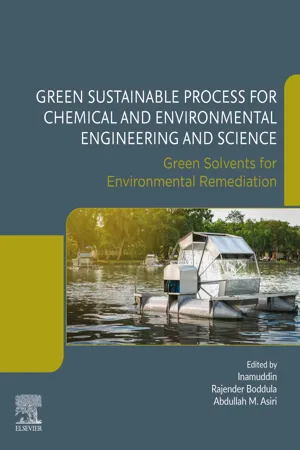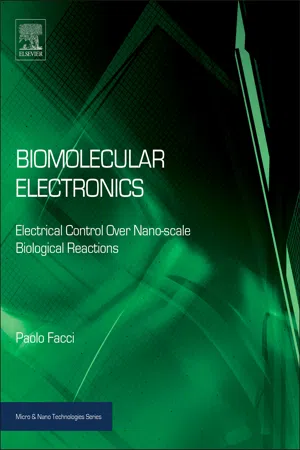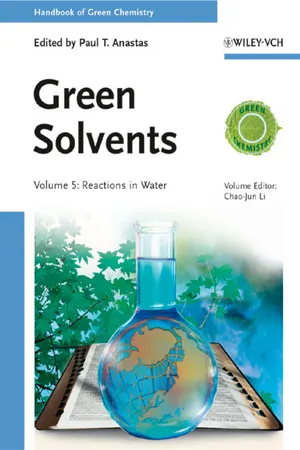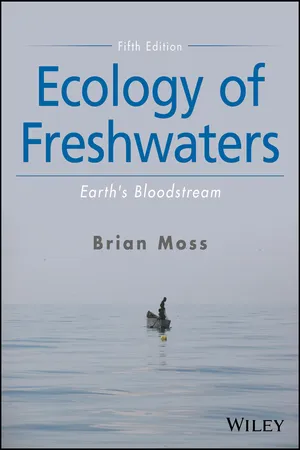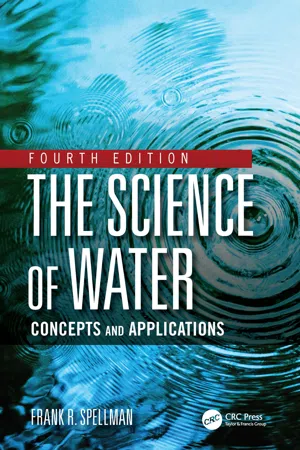Biological Sciences
Water as a Solvent
Water is a versatile solvent due to its polar nature, allowing it to dissolve a wide range of substances. In biological systems, water's solvent properties are crucial for transporting nutrients, removing waste, and facilitating chemical reactions within cells. The ability of water to form hydrogen bonds with other molecules contributes to its effectiveness as a solvent in biological processes.
Written by Perlego with AI-assistance
Related key terms
Related key terms
1 of 4
Related key terms
1 of 3
7 Key excerpts on "Water as a Solvent"
- Hanna Staroszczyk, Zdzislaw E. Sikorski, Hanna Staroszczyk, Zdzislaw Edmund Sikorski(Authors)
- 2023(Publication Date)
- CRC Press(Publisher)
The heat of water vaporization is much higher than that of many other liquids. As is the case with melting ice, a large amount of thermal energy is required for breaking hydrogen bonds in liquid water, to permit water molecules to dissociate from one another and enter the gas phase. Perspiration is an effective mechanism of decreasing body temperature because the evaporation of water absorbs so much heat.A relatively large amount of heat is required to raise the temperature of 1 g of water by 1° C because multiple hydrogen bonds must be broken in order to increase the kinetic energy of the water molecules. Due to the high quantity of water in the cells of all organisms, temperature fluctuation within cells is minimized. This feature is of critical biological importance because most biochemical reactions and macro-molecular structures are sensitive to temperature. The unusual thermal properties of water make it a suitable environment for living organisms, as well as an excellent medium for the chemical processes of life.3.2.5 Water as a Solvent
Many molecular parameters, such as ionization, molecular and electronic structure, size, and stereochemistry, will influence the basic interaction between a solute and a solvent. The addition of any substance to water results in altered properties of that substance and of the water itself. Solutes cause a change in water properties because the hydrate envelopes that are formed around dissolved molecules are more organized and therefore more stable than the flickering clusters of free water. The properties of solutions that depend on a solute and its concentration are different from those of pure water. The differences can be seen in such phenomena as the freezing point depression, boiling point elevation, and increased osmotic pressure of solutions.The polar nature of the water molecule and the ability to form hydrogen bonds determine its properties as a solvent. Water is a good solvent for charged or polar compounds and a relatively poor solvent for hydrocarbons. Hydrophilic compounds interact strongly with water by an ion–dipole or dipole–dipole mechanism, causing changes in water structure and mobility and in the structure and reactivity of the solutes. The interaction of water with various solutes is referred to as hydration. The extent and tenacity of hydration depend on a number of factors, including the nature of the solute, salt composition of the medium, pH, and temperature.- eBook - ePub
Green Sustainable Process for Chemical and Environmental Engineering and Science
Green Solvents for Environmental Remediation
- Rajender Boddula, Abdullah M. Asiri(Authors)
- 2020(Publication Date)
- Elsevier(Publisher)
[7] . Polar- and ionic-bonded materials are able to dissolve in water quickly under room conditions, although this dissolution slows down for polar compositions at high temperatures.Water's abundance and availability, in some geographic locations at least, makes it readily available and cheap to extract from the environment in modest quantities for industrial processes. Its widespread accessible in its natural form at various salinities, plus its nontoxic qualities, inexpensive procurement, and its inability to combust all make it a desirable and easy solvent to handle. Furthermore, because water remains in liquid form at standard pressure conditions and exists in that state over a useful temperature range (0–100 °C) it is convenient to handle and apply in many industrial-scale chemical and physical processes. Water also has substantial capabilities as a transportation medium; it is able to transport miscellaneous materials, including valuable nutrients. In addition, many important and useful biological processes are able to occur and flourish in the presence of water, indeed, many of the processes that make life possible on Earth. On a large environmental scale, water helps to stabilize temperatures in most climatic regions around the planet, a feature that many organisms exploit in helping them to survive. It is water's high heat capacity that is primarily responsible for its climatic impacts on a global scale.It is the combination of all these characteristics of water that underpin its viability as a solvent from the microscale to large industrial scales.2: Water's key characteristics as a solvent
Water has the capacity to dissolve and/or solubilize a wider range of materials and substances than most other chemicals [8] . Its solvency is specified partly through its dipole-moment properties; the numerical quantification of its dipole end and the scale of their charge (1.8546 Debyes). This is also related to its relative-permittivity property (symbol “ɛ r ”) which is a relative measure of its polarity. It is relative to free space (ɛ 0 = 1.85 × 10− 12 F/m). The relative static permittivity of water is high, about 80 at room temperature, compared to about 2 for a C6-alkane in such conditions. The polarizability property of water (symbol “π⁎ ”) also influences its capacity as a solvent. Although water is a very polar molecule, it is much less so than many hydrocarbons, such as alkanes. Polarizability is usually measured in cubic centimeters or angstroms cubed (10− 24 cm3 ) [9] and water displays some anisotropy in its values depending on its ionic constituents [10] - eBook - ePub
Biomolecular Electronics
Bioelectronics and the Electrical Control of Biological Systems and Reactions
- Paolo Facci(Author)
- 2014(Publication Date)
- William Andrew(Publisher)
Chapter 3Life and the Water-Based Environment
Abstract
This chapter starts by considering the unique properties of the “solvent of life”, that is, water. After briefly reviewing its most salient characteristics and providing information on their possible theoretical treatment, the role of water in biology will be considered, especially as far as its effect on the structure and function of biomolecules and biostructures is concerned.The reminder of the chapter is dedicated to reviewing key biological reactions (e.g., electron and proton transfer), systems (ion channels, bacterial photosynthetic reaction centers) and processes (electron-transfer chains in mitochondria, chloroplasts) that take place and operate in a water-based environment. Lastly, the concept of the thiol-disulfide exchange reaction is introduced, as it will be used very often in the remainder of the book as the reference reaction for implementing electrical control of the biological redox state.Keywords
properties of water ; biological macromolecules and their assemblies ; proteins ; biomembranes ; electrical conduction in water ; voltage-gated ion channels ; photosynthetic reaction centers ; thiol-disulfide exchange reactionsChapter Outline3.0 The peculiar chemical-physical properties of water 493.1 The hydrogen bond and the structure of water 513.2 The hydrophobic effect 533.3 The role of water in biology 563.4 Water and biomolecules 563.4.1 Protein folding 573.4.2 Protein structure 573.4.3 Protein activity and dynamics 583.4.4 Protein–ligand interactions 583.4.5 Water and nucleic acid structure 593.4.6 Lipids and membranes 603.5 Biological reactions taking place in water 613.5.1 Water and proton transfer - eBook - ePub
Foods That Harm, Foods That Promote Health
A Biochemical and Nutritional Perspective in Health and Disease Prevention
- Stefan A. Hulea, Ahmadi(Authors)
- 2021(Publication Date)
- Universal Publishers(Publisher)
In this way, protons can travel over a considerable long distance, which has important biological consequences. Water can also be the end product of a metabolic pathway. Thus, the degradation of sugars and fatty acids yield the metabolic water.Water, despite what some people think, is a reactive molecule available in many systems at high concentration. However, at room temperature water reactivity is greatly diminished due to the presence of H bonds. By dissociating in H+ and OH- water makes possible many biochemical reactions. At high temperatures there is a massive reduction in the number of H bonds so water becomes more reactive than at ambient temperature.It is not our intention to go further into details of the physical properties of water clusters in bulk or ice form since they are much better explained in two recent texts (2 , 3 ).3.2. Water in biological systems
There is a fair proportion of ordered water molecules in living systems. Thus, inside cells water molecules “coat” substrates and enzymes as ordered shells. As substrates bind to enzymes some of this ordered water shell is removed. What is important to bear in mind is that there are regions of ordered water around micro- and macromolecules in all cell compartments. These ordered water shells exist because of H bonds between water and various organic molecules. That explains why water is such a good solvent for so many substances ranging from ionic (charged) to polar (neutral).With the former water interacts electrostatically while with the latter it forms H bonds. That also explains why water, among all other substances of similar molecular weight and atomic configuration is the only medium that supports life.It is now apparent that interfacial water molecules modulate protein function and that nanoconfined water is so different from bulk water that in studying it the statistical physics models developed for bulk water cannot be applied to the former. It is also apparent that physical properties of water can play a key role in the orchestration of cell machinery. The fuzzy structures observed in the hyaloplasm long ago by the eminent cytologist Keith Porter (4 ) seem to structure the nearby water molecules into a strongly constrained water, called interfacial water (5 - eBook - ePub
Green Solvents, Volume 5
Reactions in Water
- Paul T. Anastas(Author)
- 2014(Publication Date)
- Wiley-VCH(Publisher)
One possibility is supercritical carbon dioxide, which is a liquid under pressure and which has attractive solvent properties. However, unless it is completely contained and reused, it will release gaseous carbon dioxide, a greenhouse gas. Thus interest has increasingly turned to water as the solvent for chemical reactions.Water is the solvent in which biochemical reactions are performed in Nature, and it is environmentally benign. However, it is a good solvent only for organic chemicals that have polar groups, such as alcohols and carboxylic acids. This may not be an insuperable problem. Over 20 years ago we reported that the special selectivities seen in water solution (see below) were also seen in some water suspensions, where one soluble component reacted with one that was poorly soluble [1, 2]. We pointed out that such suspensions in water could well be generally more practical ways to use water in manufacturing [2]. Recently, Sharpless and co-workers described a remarkable acceleration of a reaction in such a suspension, which they called reactions ON water [3, 4]. The large reported rate effect was seen in only one particular case, but even without a large acceleration the selectivities that we describe below could perhaps make suspensions in water a practical way for the environmentally benign properties of water to be generally useful even with insoluble reaction components.One industry that has switched from VOCs to water is the paint industry. We are all familiar with the water-based paints that no longer emit strong solvent odors, and these have been widely adopted for painting automobiles, for instance. It is essentially impossible to capture all the solvent vapors that are released when a vehicle is spray painted, but when the solvent is water there is no problem.Water is not simply an environmentally benign solvent; it has special properties that are essentially unique, related to what is called the “hydrophobic effect.” This is the tendency for hydrocarbons or molecules with hydrocarbon components to avoid contact with water, and to associate instead with other hydrocarbon species in water. This is what makes aqueous soap solutions dissolve grease, and it is the driving force in biology for the associations that produce cell membranes, and that cause nucleic acids to form the famous double helix. It drives the folding of proteins into their shapes in enzymes and antibodies, and it also promotes the binding of biological substrates into enzymes and antibodies [5]. - eBook - ePub
Ecology of Freshwaters
Earth's Bloodstream
- Brian R. Moss(Author)
- 2018(Publication Date)
- Wiley(Publisher)
The consequences of these properties are important. The mean air temperature at the Earth’s surface is around 13.7 °C. Extremes of temperature run to well below the freezing point of water (0 °C) at the Poles and to well above it in the molten lavas that emerge when volcanoes erupt. The summer sun over the tropics can bring the soil temperature to 60–70 °C, painful to bare feet and perilously close to water’s boiling point of 100 °C. Both during a year and over longer periods such as glacial epochs, changes in temperature can readily shift water from its usable (to living organisms) liquid form to ice or vapour. Small changes in climate can lock enormous amounts away in polar glaciers or render moist regions arid. Small fluctuations in weather can mean that water supplies dry up or run amok as floods. Freshwater organisms, in the course of their evolutionary history, have had to cope with these uncertainties. Human societies, equally dependent on liquid water, face them continuously. Water is abundant on Earth, but mostly in unusable form for land and freshwater organisms, as ice, in deep groundwaters or, particularly, as the saline ocean. The usable supply of freshwater is small and vulnerable.There is more. Water is densest not at its freezing point but at nearly 4 °C above it, so that water bodies freeze from the surface (Fig. 4.1 ), insulating the water underneath from further cooling and generally always leaving liquid water for living organisms beneath the ice. Water also dissolves a huge range of other compounds, making it the near universal solvent that is needed for a biochemical medium; it has a high specific heat, changing temperature relatively slowly, and buffering temperature extremes for organisms living in it; it has a high viscosity, making it a ‘sticky’ medium for organisms; and its surfaces have a skin, a surface tension. All of these properties have effects on living organisms and depend on the peculiar molecular structure of water.(Photograph by Randy T (Randylikestoclimb).)Ice floats on water because the water molecules of its crystal structure are more distantly spaced than those in liquid water at the same temperature and up to around 4 °C. Lakes thus freeze from the surface downwards.Figure 4.14.2 The molecular properties of water and their physical consequences
Water has two hydrogen atoms and one oxygen atom, the hydrogens held at nearly 0.1 nm from the oxygen, jointly making an angle of 104° 27′ with it. Six electrons in the outer orbit of the oxygen are shared with one from each of the hydrogens to give the eight that complete the outer shell of oxygen; two from oxygen are shared to complete the outer shell of the hydrogens. If that were all there was to it, water would be an unremarkable covalent compound and a gas at Earth temperatures. There would be no life on Earth, no ocean, no ice caps, simply a very hot, completely dry, rocky waste. - eBook - ePub
The Science of Water
Concepts and Applications
- Frank R. Spellman(Author)
- 2020(Publication Date)
- CRC Press(Publisher)
solute is the component that is dissolved. In water solutions, water is the solvent. Water can dissolve many other substances—given enough time, there are not too many solids, liquids, and gases that water cannot dissolve. When water dissolves substances, it creates solutions with many impurities.Generally, a solution is usually transparent and not cloudy. However, a solution may be colored when the solute remains uniformly distributed throughout the solution and does not settle with time.When molecules dissolve in water, the atoms making up the molecules come apart (dissociate) in the water. This dissociation in water is called ionization . When the atoms in the molecules come apart, they do so as charged atoms (both negatively and positively charged) called ions . The positively charged ions are called cations , and the negatively charged ions are called anions .A good example of the ionization occurs when calcium carbonate ionizes:
Another good example is the ionization that occurs when table salt (sodium chloride) dissolves in water:↔CaCO3calcium carbonate+Ca++calcium ion(cation)CO32 −carbonate ion(anion)
Some of the common ions found in water are listed as follows:↔NaClsodium chloride+Na+sodium ion(cation)Cl−chloride ion(anion)Ion Symbol Hydrogen H+Sodium Na+Potassium K+Chloride Cl−Bromide Br−Iodide I−Bicarbonate HCO3 −Water dissolves polar substances better than nonpolar substances. This makes sense when you consider that water is a polar substance. Polar substances such as mineral acids, bases, and salts are easily dissolved in water, while nonpolar substances such as oils, fats, and many organic compounds do not dissolve easily in water.Water dissolves polar substances better than nonpolar substances—only to a point. Polar substances dissolve in water up to a point—only so much solute will dissolve at a given temperature, for example. When that limit is reached, the resulting solution is saturated. When a solution becomes saturated, no more solute can be dissolved. For solids dissolved in water, if the temperature of the solution is increased, the amount of solids (solutes) required to reach saturation increases.
Index pages curate the most relevant extracts from our library of academic textbooks. They’ve been created using an in-house natural language model (NLM), each adding context and meaning to key research topics.
Explore more topic indexes
Explore more topic indexes
1 of 6
Explore more topic indexes
1 of 4

